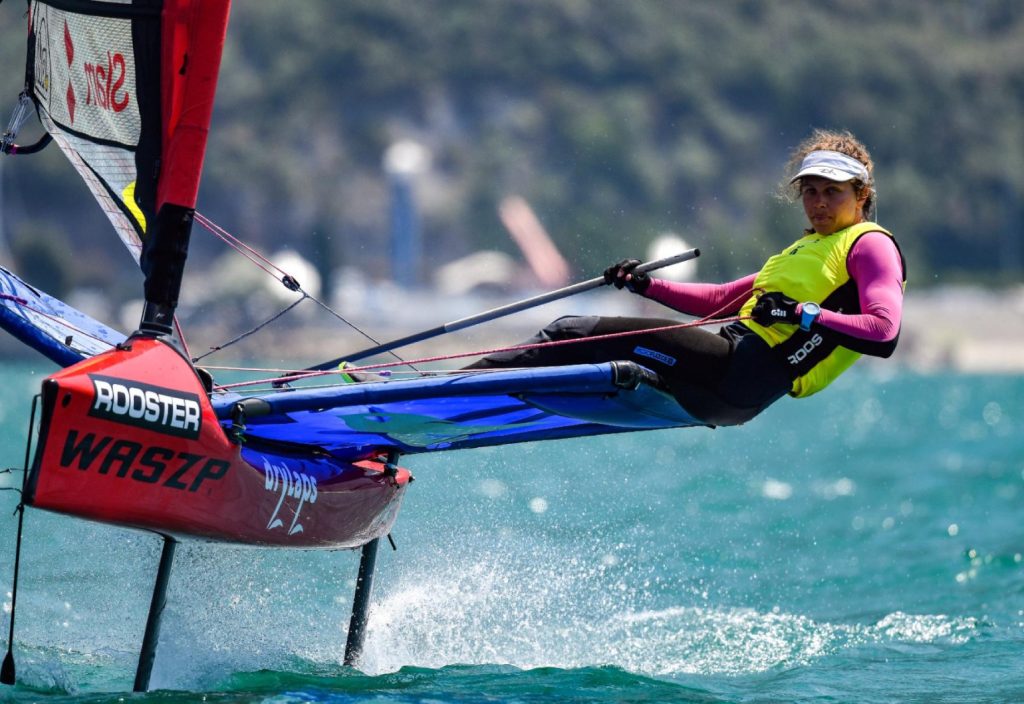There’s a quote that says ‘When love and skill work together, expect a masterpiece’.
In the case of Elise Beavis, one of the engineers behind Emirates Team New Zealand’s success at the last two America’s Cup events, that masterpiece is her analysis of crew aerodynamics that led to the team’s cyclors (a portmanteau of cyclist/sailors) advantage.
“While I was overseen by a much more experienced fluid dynamicist, the crew aerodynamics was really my project which I’d started as a very green intern so having the results all line up and be accepted by the rest of the team was a first significant achievement,” Elise said.
Elise joined Emirates Team New Zealand (ETNZ) two years before the 2017 America’s Cup, during which time she mostly worked on 3D modelling for aerodynamic computational fluid dynamics (CFD) and 3D printing, particularly looking at crew aerodynamics and comparing the different grinding versus cycling configurations.
When comparisons indicated the potential of four people inline cycling, Elise ran more CFD simulations to replicate the geometry and conditions of the wind tunnel to ensure the trends were the same as the complete yacht runs.
“They lined up fairly well so we took the next step and used a wind tunnel at the University of Auckland for two days. A whole range of configurations were tested and ultimately compared to the CFD,” Elise said.
“In the end, the full yacht, wind tunnel and CFD representing the wind tunnel tests lined up well enough that we had confidence in the crew CFD going forward.”
[embedyt] https://www.youtube.com/watch?v=ngtWMRUevD0[/embedyt]
Confirming her course
The strategy brought success in Bermuda in 2017 and again in Auckland in 2021. However Elise is also enjoying personal success, being recently named the University of Auckland’s Young Alumna of the Year and aiming for her third world championship in the single-handed foiling Waszp class.
In fact it was her love of sailing that cemented her decision to study engineering. Despite being strong in maths and science at school, it wasn’t until her mother took her to an information evening at the University of Auckland that she learned about engineering science, the most mathematical of the specialisations includes computation techniques to simulate real world processes such as fluid dynamics, optimisation of networks and geothermal processes.
“Before that time, if asked what engineering was about, I would have said car engines and bridges. Cars are something that I’m stubbornly against being interested in due to my father being excessively interested in cars,” she said.
“When I conducted some further research about what engineering science encompassed I saw on the website a list of three examples that an engineering scientist might tackle. One of those was ‘How can a sail be designed to work in low wind conditions?’”
“As a sailor, reading that one bullet point really cemented my desire to do engineering and undertake an engineering science degree,” Elise said.
Changing tack
Elise has been sailing since she was eight and competed overseas, but says that when she finished school she realised she was more competitive academically than as a sportswomen, and that she didn’t have passion to pursue the Olympic Pathway.
Instead she turned her energies towards gaining a degree that would lead to a job within the yacht engineering industry, with the ultimate goal of working the design team at ETNZ.
“My plan was to try to find work in the yacht engineering industry as soon as possible but I was cognisant that it isn’t a huge industry and that I may need to start elsewhere – particularly with regard to my summer internships,” she said.
However she was lucky the first time and gained an internship at Pure Design and Engineering, an engineering consultancy specialising in the design of composite yachts.
“This was a great introduction to yacht engineering but as I continued my degree and undertook a second summer at Pure I decided that I was more interested in the fluid dynamics and CFD than FEA and structural analysis.
Elise was surprised to get the internship which rolled into a job at ETNZ straight out of university.
“I thought that I’d need to get more experience elsewhere first so having the chance to undertake an internship with the team and then my work during that internship showing sufficient worth to be offered a job was beyond my expectations.
“I have been aware of Emirates Team New Zealand for as long as I can remember so I knew the job existed on the leading edge of sailing and technology. It was more about having sufficient experience and skills to be able to have a chance to get in the door,” Elise said.
Elise had put sailing on hold while completing her degree, but about a year into working at ETNZ she returned to the sport.
“I do more sailing and racing earlier in the campaign while work is less busy then as the campaign progresses and work gets more busy I sail less. It’s a balance between two things that I really enjoy and has meant that I continue to love the sport of sailing,” she said.
Making headway
Elise’s career plan is to “keep doing what I’m doing.”
“My role in the team is quite varied which is something that I enjoy. As my work extends into different areas this increases my skill set and helps me to even more appreciate all of the aspects which go into designing an America’s Cup yacht or other project.
“For example, when I started at ETNZ I spent a lot of time looking at aerodynamics and running CFD; however, earlier in this campaign I undertook a few projects in aero/hydrodynamics which introduced me to the challenges of multiphase CFD,” she says.
“I’m doing what I love and there is no job in the world that I’d trade it for at this stage of my life.”
